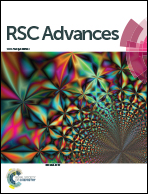Insights into the binding of photothermal therapeutic agent bismuth sulfide nanorods with human serum albumin†
Abstract
The biomedical application of bismuth sulfide (Bi2S3) nanorods as a nanomedicine for the photothermal therapy of tumors prompted this study into their interactions with human serum albumin (HSA) to understand their pharmacokinetics. Bi2S3 nanorods with orthorhombic crystalline structure were synthesized using a simple microwave irradiation method from bismuth nitrate, sodium sulfide, and starch in an aqueous medium. The synthesized Bi2S3 nanorods and their formation mechanism were well-characterized by powder X-ray diffraction (XRD), high-resolution transmission electron microscopy (HRTEM), selected area electron diffraction (SAED), and energy-dispersive X-ray (EDX). The interactions of the Bi2S3 nanorods with HSA was investigated by absorption spectroscopy, fluorescence spectroscopy and circular dichroism spectroscopy. The absorption and time-resolved fluorescence spectroscopy studies confirmed that the Bi2S3 nanorods interacted with HSA through a static mechanism. The steady-state and synchronous fluorescence spectral studies showed that the single binding site is near the tryptophan moiety (Trp-214) in HSA. The moderate binding constant determined from the steady-state fluorescence study suggested the possibility of effective transportation of Bi2S3 nanorods inside the body. These results could be very helpful for understanding the mechanisms and pathways responsible for the uptake, distribution and catabolism of Bi2S3 nanorods in multiple tissues of the human body.


 Please wait while we load your content...
Please wait while we load your content...